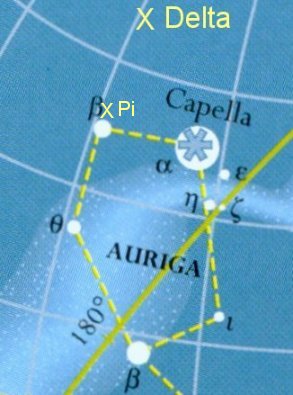
 |
Dominated by Capella, Auriga lies within the Milky Way. Beta Tauri (Elnath), toward the bottom, is also Gamma Aur (see the Greek alphabet). The yellow curve that sweeps from upper right toward lower left is the Galactic Equator, where "180 degrees" marks the Galaxy's Anticenter. Theta, Beta (Menkalinan), Pi, and Delta Aurigae closely line up along the Solstitial Colure (the curved line immediately to the left of them), and thus point the way to the North Celestial Pole and Polaris. The map is based on coordinates for 1950, when the line that connects Theta, Beta, and Delta was to the west of the Colure. Precession has since moved the line to the other side. Theta, Beta, and Delta lay almost exactly on the Colure in mid-2005; Pi passed over a bit earlier, in late- 2000. (See Auriga in context on the larger map.) |